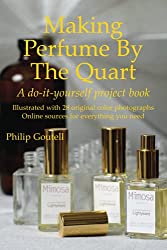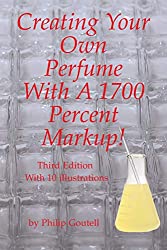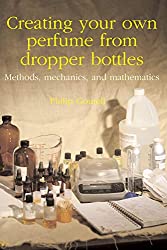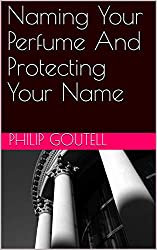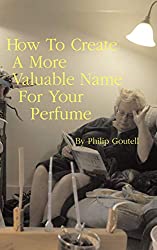Closures
"Closure" refers to the device used to seal your bottle. It will be either a simple screw-on cap or a fine mist spray pump. Closures are distinguished by "type" and "finish." "Type" refers to the way in which the closure attaches to your bottle. "Finish" refers to its size. Your bottles and closures must share the same finish in order to get a proper seal.
Types
Closures can be of three types — screw-on, crimp, and press-on.
Caps
If you use a cap to seal your bottle it will be a screw-on. To use the fragrance your customer must unscrew the cap; to seal it, he or she screws the cap back on again. If you used any other type of cap — such as a cap for a soda bottle, once you uncapped the bottle you wouldn't be able to get the cap back on again — you would have to use the whole bottle of perfume or cologne without being able to reseal it!
Screw-on pumps
Like caps, fine mist spray pumps can also be obtained with a screw-on thread. These are commonly used for short runs where the assembly work is being done by hand. Anyone can screw a pump onto a bottle if both are threaded. You don't need a machine to do it.
Crimp-style pumps
For a number of years crimp-stye pumps have been the standard for commercial fragrances being produced in quantity. The pump fits over the neck of the bottle and is then crimped — by machine — around a ridge in the bottle's neck.
Purchased in bulk, crimp-style pumps can be considerably cheaper than threaded (screw-on) pumps. It the early days of crimp-style pumps, — fifty or more years ago — the crimped part of the pump could look ugly. Today they look fine. Upscale marketers frequently put a collar around the crimped area of the pump so it doesn't even show.
Crimp-style pumps are generally attached to bottles by machines that fill the bottle, set the pump in place, and then crimp it to the bottle, all automatically. An operator may feed bottles to the machine as the bottles are glass — and breakable — and (unless buying by the ton) generally come packed in boxes that, themselves, do not allow automatic feeding.
Manual crimping machines do exist. They are sometimes called "laboratory models." They are not cheap and they are not perfect. In using them a certain number of bottles may be broken. But it is worth being aware that large, automated machines are not the only tools that can be used to attach crimp-style pumps to bottles.
Press-on style pumps
The same machines that crimp sprays to bottles can also press on "press-on" style pumps. The action of the machine is similar but, for the press-on pump, the "inward" motion is eliminated and the pump is attached by a simple downward thrust.
From your point of view all that matters it that is it is generally done automatically, by machine, and your filling house will have a machine to do it.
Finish
"Finish" refers to the neck configuration of bottles and their matching closures. Trade associations have set standards for sizes but not all manufacturers adhere to them. Today sourcing for bottles and closures is global and when buying either bottles or closures, it is important to review samples — or buy both bottle and closure from the same distributor — to insure a secure fit.
Threaded sizes
Bottles with threaded necks — also referred to as "screw neck" or "continuous threaded neck" — require closures with matching thread sizes.
Threaded finishes are referred to by two numbers, the first indicating the outer diameter of the bottle's neck in millimeters; the second, the thread configuration. Thread configuration is based on how many times the threads pass one another.
Common finishes for threaded bottles and closures would include 13/415 (13mm, 2 thread turns), 15/415 (15mm, 2 thread turns), 20/415 (2mm, 2 thread turns), 24/400 (24mm, 1 thread turn.)
Crimp and press-on
Bottles and closures for crimp and press-on style closures are defined by a single number indicating the outer diameter of the bottle's neck at its widest point in millimeters. The closure will fit over this rim and lock under it. Common sizes for perfume bottles using a crimp or press-on closure include 13mm, 17mm, 18mm, and 20mm.
Resources
5000g / 0.01g Portable electronic balance laboratory digital scale features white backlight function for convenient reading in the darkness. Lightweight and small-sized design makes it portable in use. It features high-precision and good performance, which ensure the accuracy of measurement. High quality keeps it durable and stable during use.
Specifications:
1. Max. Weight Range: 5000g
2. Accuracy Resolution: 0.01g
3. Units: g, kg, ct, oz, ozt, lb, dwt, %, tol, mm
4. Display: LCD
5. Background Light Color: White
6. Material: ABS
7. Pan size: 180* 140mm
8. Power Adapter: AC 90V-240V(Input); 8.5V,500mA(Output)
- COMPLETELY PURE - Although tap water has been filtered to make it safe for human consumption, it still contains trace minerals. Our sterile water has been thoroughly purified and mineral-free.
- ENSURE TOTAL ACCURACY - When conducting lab tests, using tap water can introduce impurities that affect the chemical composition. Deionized water will get you the most accurate results.
- A STABLE INGREDIENT - Pharmaceuticals, cosmetics, and hygiene products use distilled or deionized water. Its purity makes it a reliable choice for maintaining product safety and integrity.
- SUITABLE FOR MACHINERY - Deionized water is also widely used in industrial applications. Cleaning, cooling, and lubricating with it as opposed to regular water helps prevent corrosion damage.
- GREAT FOR CARS - Whether you're topping off your car's coolant system or washing off dirt and grime, this sterile 1 gallon bottled water is a smart choice. Prevent water spots on your vehicle!
Stainless Steel Funnels for Kitchen: These stainless steel funnels are made of food grade stainless steel, non-toxic and sturdy. Premium material makes these small funnels have a long usage time and resists breaking, bending, scratching, rusting. Each Stainless Steel funnel has a perfectly narrow stem, ideal for filling small bottles and containers while keeping the kitchen counter free from spills. Each funnel's stem is equipped with an indent (air release channel), which allows funnels to vent and allows contents to flow better. Perfect for adding salt, pepper, herbs or spices into shakers or jars; transferring oils and vinegars into cruets or small decorative bottles for gifts; adding powdered drink mixes into water bottles and much more.
3.3 Borosilicate glass, Griffin low form, 3 sizes - 50ml, 100ml, 250ml, Extra large marking spot, ASTM Specification E960, Type I requirements.
Homemade perfumes generally lack commercial value, regardless of how wonderful they may be, because their creators fail to record how their perfumes were made. To profit from a perfume, to sell it, to sell the rights to it, or have somebody sell it for you, you must be able to make more of it. To make more you need the formula, the record of how the perfume was made: what materials were used and how much of each material was used. While the formula is nothing more than a recipe, a simple piece of paper, it is the key to unlocking your perfume's commercial potential. With the formula in your hand you have the ability to make a few dozen bottles more or, like the celebrities, tens of thousands of bottles. How to create an international production formula for your homemade perfume is a guide to getting you started on the right foot, correctly documenting everything you do as you are doing it, and then using these notes with some basic mathematics to write a simple, accurate, universal formula for your perfume. Writing formulas for your perfumes can change the way you think about them. With your formulas in hand your creations are no longer "here today, gone tomorrow." Now, thanks to your library of formulas, your perfumes become immortal!
While much is written about perfume – the beautiful fragrances... the beautiful bottles – little is available on the "mechanics" of perfume production – the steps that take place on the "factory floor" where a beautiful vision is turned into a finished product, a "ready to sell" perfume. Now you can experience all of these steps, hands on, by making just one quart of your own perfume. If you follow each chapter and do what you are instructed to do, you will end up with from 8 to 64 bottles of your own perfume, depending on the capacity of the bottles you select. Along this "insiders journey," each step is profusely illustrated with professional color photographs and you'll learn — • Exactly what alcohol you'll need and where to get it • Why you'll want (just a little!) water in your perfume • What type bottles you'll need and why you cannot use others • Why you will use a spray and not a cap • How to fill and seal your bottles • How to label your bottles with the correct information so they will be legal for sale • How to select a name for your perfume that will allow you to acquire powerful trademark rights free. If you are a developer of scents you are encouraged to use one of your own for this project. If you are not a scent creator yourself you'll learn how to get a fragrance oil that is exactly right for this project. Online sources are given for all required supplies and materials. Nothing can hold you back from starting your project immediately!
Perfume is famous for the markup it can achieve, even for a middle market fragrance. While "everybody knows" that perfume costs next to nothing to make (not completely true) the making of it is often considered an esoteric secret. "Creating Your Own Perfume With A 1700 Percent Markup!" details how a 3-person company with no experience created their own fragrance in response to a marketing opportunity that was too good to pass up. The book explains exactly what was done to create a fragrance for that opportunity but it is far more than a history of the author's project. "Creating Your Own Perfume With A 1700 Percent Markup!" lays out every step in the process of creating your own perfume, either as a do-it-yourself project – and without the benefit of automated equipment some compromises and workarounds are required – or full bore professional production under your supervision. Either way you will be producing a quality fragrance at a remarkably low cost. Do you have a marketing opportunity that would be wildly profitable if only you could obtain your fragrance at a ridiculously low cost? "Creating Your Own Perfume With A 1700 Percent Markup!" is the guide you need to do it.
Now when you make your own perfume you can make it fully "commercial" meaning you will be creating a product ready for regular, continuous sales to friends, relatives, and the public! If the fragrance you've made has already won praise, why not share it with others? Some might pay you for it and want it for their web stores or retail boutiques! Creating your own perfume from dropper bottles: Methods, mechanics, and mathematics guides you through steps that can turn your hobby project into a perfume business. Discover how close you are now and how little more you must do to take what you made with essential oils and dropper bottles into a business of your own! For an introduction to this book, watch this video.
You can build a perfume business of your own using this business plan as a guide. By following its detailed strategy you learn to identify motivated groups of potential perfume buyers. Members of these groups are near the tipping point of desire for a new perfume. You don't know these people and they don't know you but you know a marketer they trust, one who does not currently sell perfume and might never think of selling perfume were it not for your approach. Here is where you step in with a professional plan, promotion, and perfume to take advantage of this ripe opportunity for mutual profit. Before your first promotion has peaked, you will already be developing a relationship with your next marketing partner. Following this plan, you will gain more and more profit with each new marketing partnership.
A really great name, a special name that is just right for a particular perfume or perfume marketer (or entrepreneur with money to invest!) can be worth a ton of money. But few individuals with great ideas ever manage to cash in on those brilliant ideas. Instead they wait while others "discover" their idea, acquire legal rights to it and make all the money while they are left out in the cold without a penny having been earned for what was once THEIR idea.
If you are struggling to name your perfume and are looking for a name that will have real value, "Naming Your Perfume And Protecting Your Name" will help you weed out low value names and point you to names that have better marketing value plus the potential to become valuable assets in themselves.
If you have a great name you want to protect but no fragrance, "Naming Your Perfume And Protecting Your Name" will guide you through the simple steps you must take to acquire a legal right to that name before someone else grabs it! Best of all, "Naming Your Perfume And Protecting Your Name" shows you how to gain strong legal protection for your name without a lawyer and without spending more than pocket change.
Never had an idea for a product name? Never thought much about perfume? "Naming Your Perfume And Protecting Your Name" may stimulate your interest in a whole new game that, when played well, can make you lots of money without your having to leave the comfort of your home office.
When you name a perfume you create a valuable asset – the name itself. To sell your perfume you want the most effective name possible. But a good name can have value beyond the edge it gives your sales. In naming your fragrance you are creating a trademark and a trademark can have value independent of the product. The value of that trademark can vary. Much depends on how well, in naming your perfume, you follow the trademark "rules." How To Create A More Valuable Name For Your Perfume first helps you develop a name that will be effective in selling your perfume. It then prods you to make use of certain techniques that can turn a good name into a great trademark, strong and valuable. If you have questions about how to protect a name, How To Create A More Valuable Name For Your Perfume will answer many such as:
- Can you protect your name yourself or do you need a lawyer?
- Can you register a trademark without a lawyer?
- What does it cost to register a trademark?
- How do I enforce the rights I have established?
How To Create A More Valuable Name For Your Perfume covers both state, federal, and international protection.
For article updates, etc., add your name to Phil's mailing list.


Philip Goutell
Lightyears, Inc.






